Blog Archives
Karnataka: Discovering hidden gems
This trip was different from any of our previous trips in several aspects. Firstly, it was planned at a short notice for a short duration. Secondly, it was our babymoon (yay!) and therefore, unlike our previous trips, we did not focus on it being a backpacking one. And lastly, despite everything, we had to ensure it is unique and worthwhile, because, well, that’s how all our trips are!
Karnataka has numerous beaches. We decided to bunch a few of them in our itinerary. This was done easily with the help of Google Maps and knowing the distance between all the places we wanted to cover. Next part was choosing the accommodation. And this is where my co-wanderer’s brilliant researching skills came into play. He found the most beautiful, peaceful and exotic location we could hope for in this part of the country. So we quickly finalized the dates, booked our tickets and accommodation, and set off on yet another memorable trip on a pleasant December evening.
Day 0: Mumbai – Udupi
We took a late night train from Mumbai to Udupi, which was unfortunately delayed from the origin itself. Add to that, the seats that we got were not the best. Nevertheless, the excitement of the trip kept us in high spirits.
Day 1: Udupi – Paradise Lagoon
Our train reached Udupi 2 hours later than scheduled. After that, we had to travel another ~15 km to reach our resort. Haggling with cab drivers outside Udupi station did not help much, and we finally took a prepaid auto rickshaw (Cab drivers were demanding not less than Rs. 600, and the prepaid auto rickshaw cost us Rs. 280). It took us about 20-25 minutes to reach our destination, and we finally reached Paradise Lagoon, our abode for the next 2 nights, 3 days. This resort is located on the edge of Thonse village, right next to the backwaters of Karnataka.
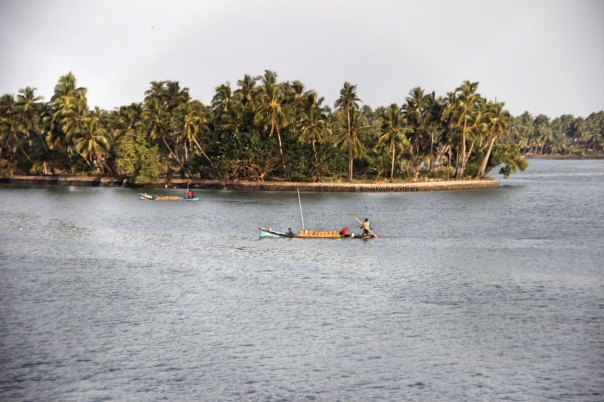
Backwaters surrounding the resort
It is a charming little resort, with just about 20 rooms currently operational (they were constructing 5 additional rooms while we were there). They have different types of rooms, ranging from standard to deluxe to cottages, and even a couple of houseboats). Needless to say, we had booked the best room possible – the waterfront cottage! We checked in to our room, and were greeted with the most amazing view from our balcony!! Our balcony overlooked the infinity pool, which further stretched into the backwaters. 🙂
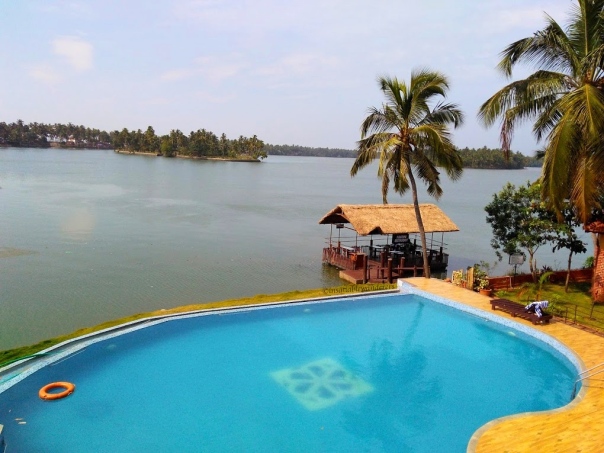
Majestic view from our balcony
We quickly placed our order for lunch and freshened up. When we went downstairs for having lunch, we had 2 options for seating – normal restaurant and floating restaurant (yes, that’s right!). We proceeded to the floating restaurant and had a wonderful experience of eating there. The restaurant overlooked the backwaters, which provided much-needed serenity. After lunch, we headed back to our room for a well-deserved siesta, after the long journey.
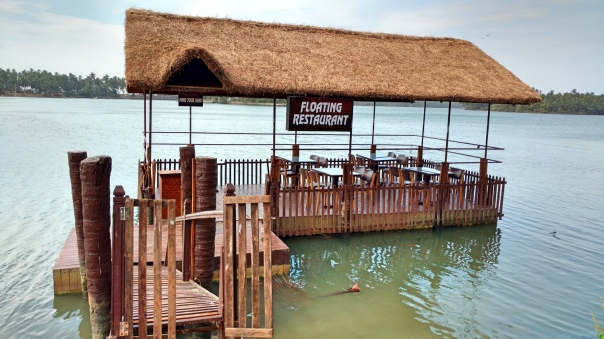
Floating Restaurant
In the evening, we strolled around the resort, exploring the lovely place. Apart from the infinity pool (their main attraction), Paradise Lagoon also has a fishing deck, paddle boat, swings, kids’ play area, a library, and indoor games such as table tennis, snooker, carrom, etc. Furthermore, there are benches placed strategically around the resort, providing beautiful views of the backwaters. After playing some games, we returned to our room and enjoyed the view from our balcony, while sipping tea.
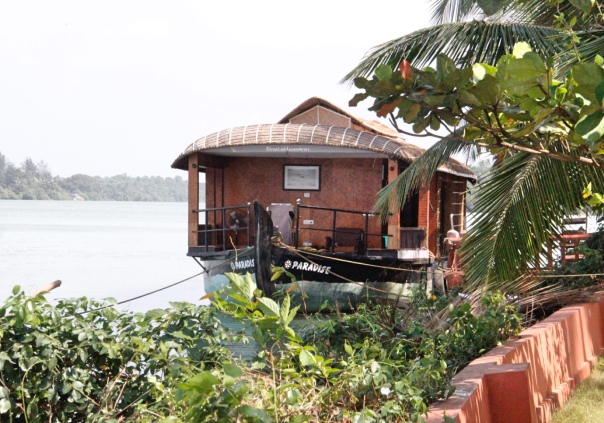
Houseboat Accomodation
At night, we had dinner in the normal restaurant, which wasn’t half bad. Being explorers, we spent some time chatting with the staff, getting to know the place a bit better. Dinner was followed by another stroll, before we retired to our room for the night.
Day 2: Hoode beach, Delta point
Paradise Lagoon has few attractions nearby, such as Hoode beach, Delta point, Malpe beach, and St. Mary’s island. Of these, Hoode beach is about 1 km away and can be accessed on foot. We decided to go for a morning walk to Hoode beach. Although we did not wake up as early as planned, we went for our walk. The walk took us through Thonse village, where we saw the village folks rushing about for their daily chores. We spent few minutes on the beach and headed back to the resort, planning to come back later. The walk to the beach made us hungry, and we quickly proceeded towards the restaurant for breakfast.
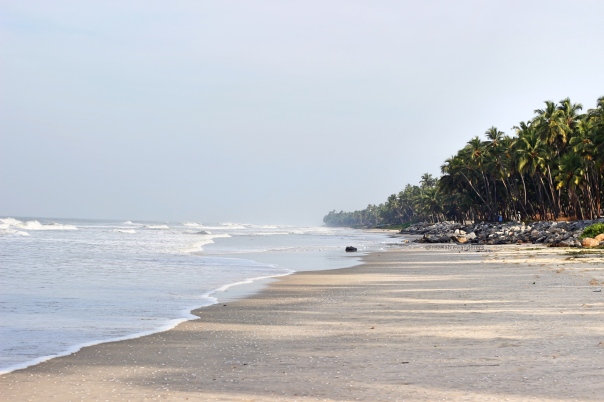
Hoode Beach
Post breakfast, my fellow wanderer tried his hand at fishing, while I just sat on one of the benches and admired the view. The weather seemed a bit hot for paddle boating, so we played some more indoor games, and I read some books from the library. Thereafter, we went back to our room and lazed around until lunchtime. After lunch, we lazed around some more! 😛
In the evening, we requested the staff to arrange an auto rickshaw for us to visit Delta point. There was a cyclone warning in the area, hence we had to drop Malpe beach and St. Mary’s island from our itinerary. Delta point is about 15 minutes away from Paradise Lagoon, and on our way, we halted at another stretch of Hoode beach. This part of Hoode beach was much cleaner and a lot more beautiful than the one we visited in the morning. After spending some time on the beach, we continued towards Delta point.
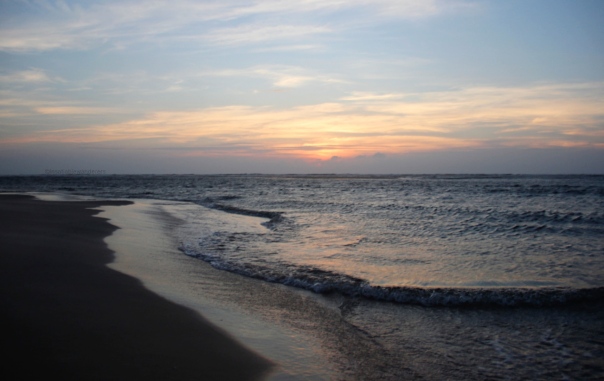
Sunset at Hoode Beach
Delta point is where the sea water meets the backwaters. It is a popular evening spot amongst the locals. And yet, it is not commercialised. It is a clean virgin beach, where families come to play in the sand or walk along the seashore. We also spotted some fishermen trying to catch the last fish for the day before sunset. Overall, it was a lovely experience, before we returned to the resort.
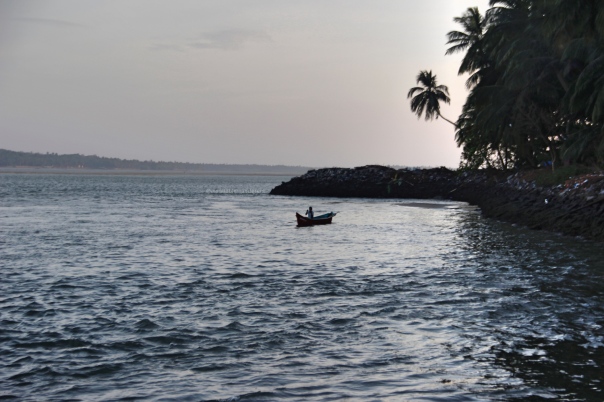
Delta Point – backwaters meeting hoode beach
Our day’s activities were not over yet. We still had to experience the resort’s best attraction – the infinity pool! We quickly changed into our swimwear and plunged into the pool. The water was just the right temperature, and we spent over an hour, feeling rejuvenated in the lovely pool beneath the stars. This was followed by a simple dinner and a good night’s sleep.
Day 3: Paradise Lagoon – Udupi
Bird photography is another of my fellow wanderer’s hobby. And through his intensive research, he knew that Paradise Lagoon and the backwaters housed some beautiful birds. So, the next morning we woke up early, and armed with our camera, started roaming around the length and the breadth of the resort. By breakfast time, he managed to capture some amazing clicks, including a kingfisher! 🙂 . After breakfast, we spent some time sunbathing near the pool.
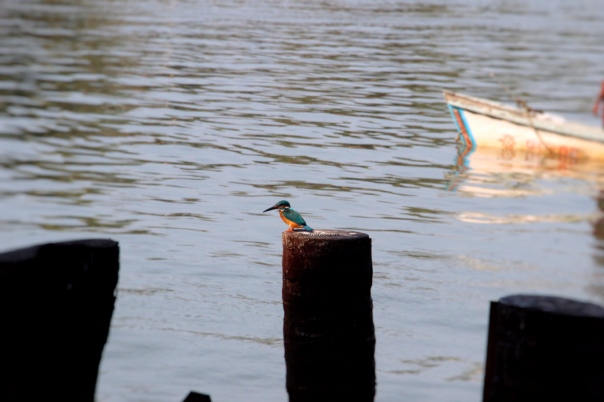
Common Kingfisher
Around noon, it was time to check out, and bid goodbye to this wonderful secluded place, which the staff fondly called ‘God’s new country’.
We had booked return tickets to Mumbai for the next day, as we wanted to spend some time in Udupi too. We sought accomodation in a simple but clean hotel in Udupi, had our lunch, and settled down for another siesta.
Udupi is where we could savour the real taste of Karnataka cuisine. We had goli bhaji and coffee (pronounced kaapi in Southern India) for evening snacks. Then we walked down to the main Udupi market, and bought some local delicacies for our folks back home. We had dinner at a restaurant nearby, and then returned to our hotel.
Day 4: Udupi – Mumbai
In the morning, we had buns (another Kannada delicacy) and kaapi for breakfast and headed for Sri Krishna Math (the famous Lord Krishna temple in Udupi). We offered our prayers and spent an hour or so visiting the numerous smaller temples situated within the premises of the Math. Then we headed for the langar (food served to the devotees), and had our lunch there.
Post lunch, we returned to our hotel, packed our bags, and checked out in time for our afternoon train. Thankfully, the return journey was a lot more comfortable, and we were back home the next morning, feeling relaxed, refreshed and rejuvenated.
Tips and Tricks:
- Getting there: It is advisable to have Google Maps turned on when going towards Paradise Lagoon. However, even Google Maps does not know the accurate location. Therefore, once you reach Thonse village, follow the sign boards for Paradise Lagoon. In case you need to ask a localite for directions, you can either ask for Paradise Lagoon or Thonse Medical Centre (a popular landmark, right next to Paradise Lagoon).
- Food: Being situated next a village, there aren’t any good restaurants near the resort. Hence, you will have to rely on the resort itself for all your meals. We recommend carrying some dry snacks along for the odd hunger pangs between meals. Also, the resort’s restaurant, while serving vegetarian as well as non-vegetarian dishes, mainly offers North Indian and Chinese cuisine, with very few South Indian delicacies available. Thus, if you are looking to try the authentic taste of Karnataka, this resort is not the best place for it.
- Sanctity of the place: For us, the best feature of Paradise Lagoon was the peace and quiet it offered. Even the manager mentioned to us that they are quite particular about the guests they accommodate. They would not let out rooms for party purposes, or anything that would disturb the tranquility of the place. This resort is perfect for a honeymoon, babymoon, or a serene family outing, and we would urge our readers to respect this fact and help maintain the peace if visiting Paradise Lagoon.
Magnificent Dudhsagar Waterfall: Trek to it if you have plenty of luck or stamina!
About Dudhsagar Waterfall:
Dudhsagar waterfall is one of India’s tallest waterfalls with a height of over 1000 feet and an average width of 100 feet. It is four-tiered waterfall located on the Mandovi River, inside the Bhagwan Mahavir wildlife sanctuary, in Sanguem district of Goa, close to the border with Karnataka. Though perennial, the beauty of the waterfall increases multi-fold during the rainy season. From a distance, the waterfall appears like streams of milk rushing down the mountainside.
Dudhsagar literally means ‘Sea of Milk’. According to legend, there was once a princess who used to bathe in the waterfall, and drink milk from a golden jug thereafter. Once, as she finished her bath and was drinking her usual jug of milk, she noticed a prince watching her. She poured the milk to form a curtain to hide her modesty and that is how the fall gets its name.
How to reach:
By train: The falls can be reached by a train journey from Vasco or Margao. At Kulem (or Collem), there is a railway station where the train stops to pick up passengers for the journey to the waterfalls. There are two trains a day that halt at Dudhsagar and it is possible to catch a morning train up and spend several hours at the falls before taking an afternoon train back.
By road: The easiest way to reach the waterfall is to take a 4×4 vehicle to the Dudhsagar taxi stand and hike the one km distance from the dropping point. Tours operated by GTDC (Goa Tourism Development Corporation) have Dudhsagar Waterfall as one of the tour stops, and several private operators also offer trips to the Waterfall. However, the roads leading to the waterfall, maintained by the Goa Forest Department, remain closed during monsoons and open in October.
By trek: The nearest rail station accessible by road to the falls is Castle Rock station, about 14 km from Dudhsagar falls. Visitors can either trek the 14km stretch or board a train from Castle Rock and disembark at the Dudhsagar halt. Or you can take a train up to Kulem and trek about 13km to the falls. It is to be noted that the Dudhsagar rail stop is not a station where passengers can expect a platform. Passengers and visitors have to climb down the ladder of the rail compartment in a short 1-2 minute unscheduled stop. From this rail stop, visitors have to walk about a kilometer on the tracks to arrive at the falls. This includes crossing a 200m train tunnel, which is totally dark, making the walk a bit tougher.
Our experience:
We visited Dudhsagar at the beginning of September. As mentioned above, the roads to the falls are closed in monsoon. But the beauty of the Waterfall is enhanced during rainy season. So our only options remained train or trek. Some of our friends decided to reach Kulem by train late night, and trek about 13km to reach the Waterfall. The rest of us decided to travel by train right up to Dudhsagar; we were counting on being able to alight at the unscheduled halt 😛 Both groups were expected to reach Dudhsagar at the same time.
Why did some people choose the arduous trek from Kulem if there was a train halting at Dudhsagar itself? Well, of late, there were instances of Railway Police Force (RPF) not allowing large groups to alight at Dudhsagar as there had been some mishaps at the falls recently. As the only way to reach the falls is by crossing railway tracks, safety becomes a concern, especially in case of large groups. Also, there have been instances of people falling off the slippery rocks. Hence, until safety measures are improved, RPF decided to restrict the number of visitors by preventing them from alighting from the train itself. Therefore, some of our friends took the Hubli express (starting from Lokmanya Tilak Terminus) and alighted at Londa. From Londa, they took a private vehicle to Kulem, and started their trek around 3am. The route included a jungle trek (including crossing 3 river streams), and walking on rail tracks. (In my humble opinion, such a route would seem scenic and adventurous during the day, but is neither safe nor enjoyable at night.) They reached Dudhsagar at around 6.30am.
What about the lazier group? Well, we took the Goa express from Pune (from Mumbai to Pune, we went by bus), had a comfortable journey, and managed to alight at Dudhsagar. We then proceeded towards the falls and once crossed the tunnel we saw the first view of the falls. It was beautiful! After a walk of about 1km from Dudhsagar station, we reached the magnificent falls at around 6am! 🙂
The two groups then merged, and after spending some time at the falls, we started our return journey. After walking for few minutes, we saw the Waterfall from the Kulem route, which gives a view of the falls with a railway bridge in between. The view is enhanced when a train crosses the bridge. We then trekked through Bhagwan Mahavir wildlife sanctuary and spent some time in a river stream on the way. We reached Sonaulim railway station after trekking about 4 kms, from where we boarded a train to Kulem (the alternative is to trek the 6km from Sonaulim to Kulem, but it is mostly through railway tracks, which gets boring after a while, not to mention, risky).
At Kulem, we checked into a guest house, had lunch, and rested for few hours. We then returned to Kulem station, and boarded the train to Madgaon (Margoa). From Madgaon, we boarded Matsyagandha express and reached Mumbai early next morning.
The biggest challenge for both groups was reaching Dudhsagar, with one relying on their stamina and the other on luck. The return journey was relatively uneventful. Nevertheless, we came back with a sense of accomplishment 🙂
Tips and tricks:
- Research well before deciding on your route, which would also depend on the season and your appetite for adventure!
- Carry adequate food and water. Dudhsagar waterfall has no facilities whatsoever, so you’ll find no food, drinking water, or toilets for few hours until you reach the nearest railway station or guest house.
- There are monkeys at the Waterfall, so make sure your food is well hidden inside your bags. (You can also carry a small damru to ward off the monkeys.)
- If you plan on following the trekking route, you might encounter leeches in your jungle trail, so keep salt or matchbox handy. It is also advisable to wear full sleeved t-shirts and long-bottomed track pants. Trekking shoes are a must.
- A word of caution: If you plan to go by train, and RPF officials prevent you from visiting Dudhsagar, please heed their advice. Also, be careful while walking on railway tracks and through railway tunnels, and always watch out for oncoming trains. Also, tread with caution at the Waterfall, as the rocks are slippery and the barricades are not very robust.
Cost: Approx. Rs. 1,500-2,000 per person (including train tickets, food and guest house charges).



